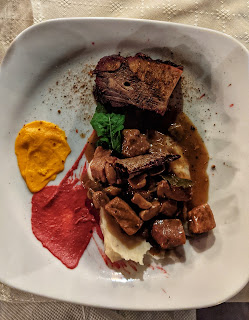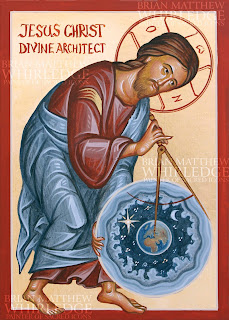Decani and Pec
Patriarchate of Pec, Church of Saint Demetrius
Prizren
We attended the Divine Liturgy this morning in the Cathedral of Saint George. Prizren was once the medieval capital of Serbia. Before 1999, more than 20,000 Serbs lived in Prizren. Today, only 20 live here, and almost all of them were at Liturgy this morning. The Cathedral was built for the Orthodox population in the 1860s, but today, the large church is mostly empty because of Albanian pogroms to force Orthdox Christian Serbs out of their homeland.
The utilities in Prizren are really wild!
The small Church Saint Andrew, across the street from the cathedral, contains some medieval frescoes in poor condition.
Theotokos of Ljevisha
The old cross-in-square basilica church of the Theotokos of Ljevisha in Prizren was frescoed by Michael Astrapas in the 14th century. Note the master's unique composition to accomodate the architecture.

One famous fresco from the 12th century remains, the treasure of the church. This is the icon of the Theotokos of Ljevisha, for whom the church is named.
Velika Hoca
Velika Hoca is a Serbian village relatively near Prizren. It is known for its winemaking. It has 13 medieval churches and one monastery. 60 years ago, Kosovo was 100% Serbian, without a single Albanian. Albanians began to creep in and their mafia and terrorists violently forced the native Serbs to leave. Villages with through-roads were quickly overtaken after 1999. Velika Hoca was saved because it is on a dead-end mountain road that the people were able to block. On the day the Albanians declared independence for Kosovo in 2004, they destroyed 154 churches, including burning the Theotokos of Ljevisha Church.
We ate lunch in a 700-year-old winery. The food was incredibly delicious, all produced by local farms. Wine is still produced as it was 700 years ago, according to family traditions. This was some of the best wine I've tasted.
Emperor Dusan had a 20-mile long viaduct to pipe wine from this winery to his palace in Prizren. A section of it is visible in the wine cellar. Talk about wine on tap!
These are the best grapes I've ever tasted in my life. They were so flavorful, big, sweet, juicy. Even the seeds were sweet!
Visocki Decani Monastery
Decani Monastery boasts the largest complex of medieval frescoes. It is absolutely breathtaking.
We had to go through a UN military checkpoint to enter the monastery grounds. Our passports were collected by armed soldiers. The monastery has been threatened ever since 1999, and the abbot insists UN peacekeeping forces remain to protect the endangered monastery.
Decani's construction was inspired by Studenica. It has strong Romanesque elements on the exterior, resembling a basilica, while the interior is the Eastern Cross-in-square. The exterior is marble, like Studenica, with many detailed carved ornaments.
Can you see the delightful gargoyles at the bases of the decorative arches?
The church was built in 1330-1338, and frescoed 1338-1348. The was site selected a century earlier by St. Sava. It was built by St. Stefan Decani, whose relics are interred in the church. They are elevated, so it is possible to crawl underneath them and venerate them.
 |
The impressive narthex has frescoes commemorating saints from every day of the year. It contains the most complete menaion (calendar) cycle.
Pec Patriarchate
Pec served as the patriarchal headquarters for 800 years since its founding by Saint Sava. It is a walled monastic complex, today inhabited by nuns. There are four churches, connected by a common large narthex. Every church is beautifully frescoed. The greatest construction was from 1330-1340.
The dome of the central church shows Christ's Ascension and enthronement in glory. The Apostles are notably emotional as their master departs. Only the Theotokos is calmly in prayer.
As the others began to leave the churches for the monastery shop, I continued sketching. There was a fresco of the Mother of God that I needed to find. It is an icon "of the sign" (Isaiah 7:14). Christ is shown mystically in her womb as she raises her hands in prayer. The fresco in St. Demetrius church in Pec is the most elegant and regal painting of this type, one I hope to reference in a future project. I had to find this fresco and spend a few minutes sketching it. However, I had already visited three of the churches and I couldn't seem to find the fourth, the Church of Saint Demetrius with this fresco. I returned to the narthex, and I found the entrance semmingly hidden in the farthest northern part of the narthex. Here was the fresco!
I spent a few minutes with this incredible fresco to make my last sketch on this trip, before Father Ilya called me away. In all, I've made hundreds of sketches in the past few weeks, and I almost filled up my second sketchbook. What a perfect way to end this wonderful trip, sketching one of my favorite frescoes on location!
Most Serbian monastery stores have at least one excellent book cataloging that monastery's frescoes with beautiful photographs. These catalogues are invaluable references for iconographers. I'm glad I loosely packed two suitcases when I left, since I filled one entirely with such books, and the other suitcase had all my clothes and everything else. When I checked in at the Skopje airport, the Austrian ticket agent offered to check my carryon bag at no cost. I'm so glad I didn't have to hoist 50 pounds over my head into the overhead compartment! When I get home, I'm going to build a bigger bookshelf for my studio!
Conclusion
Our farewell dinner featured the typical delicious Balkan fare of fresh vegetables, cheese, meat, and potatoes. While the food was wondeful, it is always hard to say goodbye to friends, new or old. I got to know so many wonderful people during our journey together to experience the greatest medieval frescoes. I am so thankful to connect with many wonderful Russian brothers and sisters in Christ. I am thankful to have developed friendships with iconographers I have admired for years, and now being invited to help with their projects. I am thankful to my parents for supporting me and driving me to and from the airport. I am thankful to the Lilly Endowment for making this trip possible. I am thankful to Father Ilya Gotlinsky for organizing this wonderful trip and bringing together Russians and Americans in this totally unique experience. I am thankful for Ivan Krucican, whose deep faith shone through and for his intimate knowledge and expertise in these frescoes, monasteries, and churches. I am thankful for my wife Rebekah for being the best wife mother, especially for her support making it possible for me to leave home for two weeks. Most of all, I'm thankful to our Lord, God, and Saviour Jesus Christ for all things.
I'm writing this post in the Vienna Airport, waiting for my flight to Chicago and reflecting on the many wonderful experiences over the past two weeks. My departure is bittersweet. I dearly miss my family, friends, and life back home and I can't wait to see them. On the other hand, I have been so inspired soaking in the presence of mankind's greatest artistic achievements for the past two weeks, and I don't want to leave. I am inspired to bring this timeless beauty with me to my continent, country, and home. I now have a mission: to fill churches with such transcendent beauty. Spending two weeks with not only the greatest frescoes, but also some of the best contemporary icon painters has pushed me to grow in my own craft and service to God.











































Comments
Post a Comment